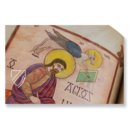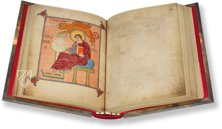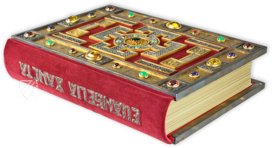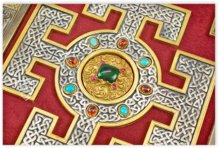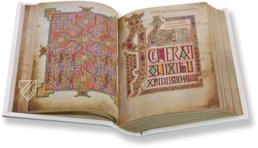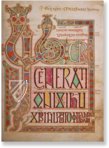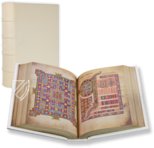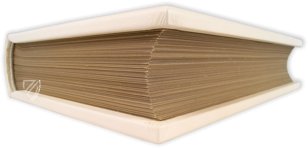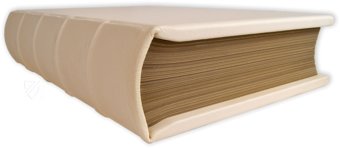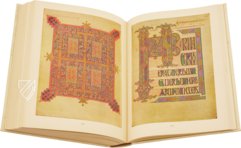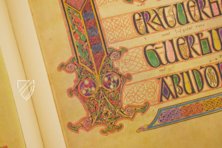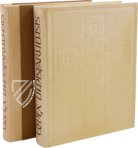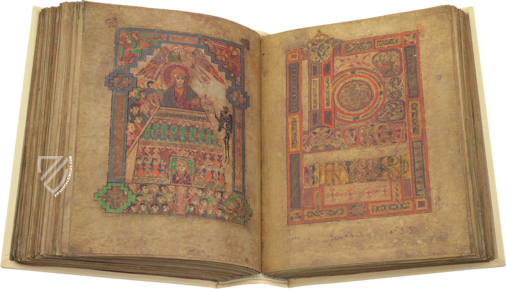Lindisfarne Gospels
(7,000€ - 10,000€)
Probably around 700 CE, several members of the English monastery of Lindisfarne on a small peninsula called Holy Island created a manuscript that today has a unique status in the history of book art. In addition to the Latin text, the Lindisfarne Gospels contain the oldest surviving translation of the four Gospels into Old English, which was completed in the 10th century in the form of interlinear and marginal glosses. Furthermore, this incomparable milestone stands out due to its fascinating illumination. Mediterranean and Celtic influences merge in the early medieval Gospel Book to create an incredibly colorful and varied illumination, which was to have a formative impact on insular book art and repeatedly served as inspiration throughout the history of art. The fact that the codex was rescued from a Viking raid to the English mainland in the 9th century testifies to the great value that was already attached to it at the time.
Lindisfarne Gospels
In the late 7th or early 8th century, an illuminated manuscript emerged from the English Lindisfarne monastery that is still considered to be one of the highest achievements of book art to this day. The Lindisfarne Gospels is a collection of the four Latin Gospels, which have been translated into Old English. As a result, the manuscript is the oldest surviving evangeliary in Old English. The adornment of the book is particularly impressively designed. 16 luxuriously-adorned canon tables inaugurate the precious work. Five unique ornament pages display Insular Illumination’s wealth of forms and colors in full splendor. Four portraits of the Evangelists round out the magical, breath-taking book illustrations.
A Holy Place of Origin
The Lindisfarne Gospels was made in the Lindisfarne Monastery, founded ca. 653. The monastery found itself on a small piece of land jutting directly from the coast of northern England, an island with the name “Holy Island”. Its scriptorium quickly developed into one of the most important artistic centers of England and was the place of origin for some true masterpieces of medieval book art. The evangeliary of the monks of Lindisfarne was dedicated to the bishop of the monastery, St. Cuthbert. Cuthbert, who lived as a hermit, enjoyed great honor and esteem from his brothers. He was sainted shortly after his death in 687, and in order to duly celebrate this event, the monks of Lindisfarne decided to compose an evangeliary in memory of Cuthbert.
Legendarily Splendid Décor
The biblical text of the Lindisfarne Gospels was furnished by Aldred, a principal of the monastic community, with Old English glosses. As a result, it contains the oldest surviving translation of the text of the Gospels into English. In the valediction of the manuscript, Aldred connected his work with the work of those who made the evangeliary: Eadrith, Bishop of Lindisfarne, wrote and adorned the book, Aethelwald, his successor, had it bound, and a hermit named Billfrith, made the metal fittings for the bindings. The astonishing pictorial decoration of the work is so diverse and beautifully painted that it lends the book a unique status in the history of book art. The canon tables and portraits of the Evangeliaries show influences from the Mediterranean and Celtic cultural areas and combine these in unique insular illumination. Insular ornamentation and braiding patterns embellish the classical columned arcades of the canon tables, which exhibit elaborate, full-page decorative initials. The five finely fleshed out ornament pages, the so-called ‘carpet pages,’ are particularly thrilling. They display Insular Illumination’s full richness of breathtaking colors and forms. The monks allowed outstanding cross shapes worked into the overall composition to vividly emerge from the tightly-wrought waddling through the use of luminous contours.
A Milestone of English History
The Viking raids of the 9th century induced the monks to relocate with the masterpiece from Holy Island, first to Chester-le-Street, and finally to Durham. One presumes that commissioners of King Henry VIII confiscated the book from the monastery in the course of secularization and because of its jewel-encrusted binding – which no longer exists – brought it to London. Today, one can gaze at one of the greatest book treasures worldwide in the British Museum.
Codicology
- Alternative Titles
- Book of Lindisfarne
Buch von Lindisfarne - Size / Format
- 518 pages / 34.0 × 24.5 cm
- Origin
- United Kingdom
- Date
- Ca. 700
- Epochs
- Style
- Genre
- Script
- Insular Uncial Insular Half Uncial
- Illustrations
- 4 Evangelist portraits, 16 canon tables, 5 carpet pages, numerous pages with decorative initials
- Content
- Jerome's Novum Opus and Plures Fuisse, Praefatio from a letter by Eusebius of Caesarea, canon tables, four Gospels
- Patron
- Eadfrith, bishop of Lindisfarne (d. 721)
- Artist / School
- Eadfrith, Bishop of Lindisfarne (d. 721) (scribe)
Aethelwald and Billfrith (bookbinders) - Previous Owners
- Durham Cathedral Priory
Thomas Turner
William Bowyer (d. 1569/70)
Robert Bowyer (ca. 1560–1621)
Sir Robert Cotton (1571–1631)
Sir Thomas Cotton (1594–1662)
Sir John Cotton (1621–1702)
British Museum
Lindisfarne Gospels
Incipit Page: Gospel of Matthew
This splendid incipit page presents the (abbreviated) first line from the Gospel of Matthew: Liber generationis Iesu Christi filii David filii Abraham (The book of the generation of Jesus Christ, the son of David, the son of Abraham). The color palette created by the artists is truly incredible, and when combined with the endless interlace, swirling patterns, and incorporating the heads of various animals, the first three letters in Liber look like a picture from the Hubble Space Telescope.

Lindisfarne Gospels
Cross-Carpet Page
Insular cross-carpet pages were inspired by contemporary metalwork and oriental rugs. Similar pages can be found in Coptic Christian manuscripts, and it is possible that this decorative tradition came to Ireland with monks who came from or spent time in Egypt. This page prefaces the letter of St. Jerome addressed to Pope Damasus, which is often found in Gospel books.
This is a symmetrical design created with an accomplished eye for detail and color. The frame consists of a chain of peafowl with interlace necks and dogs’ heads on the corners. At the top of the page, one can see two uncolored sections of interlace that the solitary artist was unable to finish and were left incomplete by others because the work was a personal act of devotion.

#1 Buch von Lindisfarne (Victorian Binding Edition)
Languages: English, German
(7,000€ - 10,000€)
#2 Buch von Lindisfarne (Leather Edition)
Languages: English, German
(3,000€ - 7,000€)
#3 Buch von Lindisfarne (Special book case Edition)
Languages: English, German
(3,000€ - 7,000€)
#4 Buch von Lindisfarne
(1,000€ - 3,000€)
- Treatises / Secular Books
- Apocalypses / Beatus
- Astronomy / Astrology
- Bestiaries
- Bibles / Gospels
- Chronicles / History / Law
- Geography / Maps
- Saints' Lives
- Islam / Oriental
- Judaism / Hebrew
- Single Leaf Collections
- Leonardo da Vinci
- Literature / Poetry
- Liturgical Manuscripts
- Medicine / Botany / Alchemy
- Music
- Mythology / Prophecies
- Psalters
- Other Religious Books
- Games / Hunting
- Private Devotion Books
- Other Genres
- Afghanistan
- Armenia
- Austria
- Belgium
- Belize
- Bosnia and Herzegovina
- China
- Colombia
- Costa Rica
- Croatia
- Cyprus
- Czech Republic
- Denmark
- Egypt
- El Salvador
- Ethiopia
- France
- Germany
- Greece
- Guatemala
- Honduras
- Hungary
- India
- Iran
- Iraq
- Israel
- Italy
- Japan
- Jordan
- Kazakhstan
- Kyrgyzstan
- Lebanon
- Liechtenstein
- Luxembourg
- Mexico
- Morocco
- Netherlands
- Palestine
- Panama
- Peru
- Poland
- Portugal
- Romania
- Russia
- Serbia
- Spain
- Sri Lanka
- Sweden
- Switzerland
- Syria
- Tajikistan
- Turkey
- Turkmenistan
- Ukraine
- United Kingdom
- United States
- Uzbekistan
- Vatican City
- A. Oosthoek, van Holkema & Warendorf
- Aboca Museum
- Ajuntament de Valencia
- Akademie Verlag
- Akademische Druck- u. Verlagsanstalt (ADEVA)
- Aldo Ausilio Editore - Bottega d’Erasmo
- Alecto Historical Editions
- Alkuin Verlag
- Almqvist & Wiksell
- Amilcare Pizzi
- Andreas & Andreas Verlagsbuchhandlung
- Archa 90
- Archiv Verlag
- Archivi Edizioni
- Arnold Verlag
- ARS
- Ars Magna
- ArtCodex
- AyN Ediciones
- Azimuth Editions
- Badenia Verlag
- Bärenreiter-Verlag
- Belser Verlag
- Belser Verlag / WK Wertkontor
- Benziger Verlag
- Bernardinum Wydawnictwo
- BiblioGemma
- Biblioteca Apostolica Vaticana (Vaticanstadt, Vaticanstadt)
- Bibliotheca Palatina Faksimile Verlag
- Bibliotheca Rara
- Boydell & Brewer
- Bramante Edizioni
- Bredius Genootschap
- Brepols Publishers
- British Library
- C. Weckesser
- Caixa Catalunya
- Canesi
- CAPSA, Ars Scriptoria
- Caratzas Brothers, Publishers
- Carus Verlag
- Casamassima Libri
- Centrum Cartographie Verlag GmbH
- Chavane Verlag
- Christian Brandstätter Verlag
- Circulo Cientifico
- Club Bibliófilo Versol
- Club du Livre
- CM Editores
- Collegium Graphicum
- Collezione Apocrifa Da Vinci
- Comissão Nacional para as Comemorações dos Descobrimentos Portugueses
- Coron Verlag
- Corvina
- CTHS
- D. S. Brewer
- Damon
- De Agostini/UTET
- De Nederlandsche Boekhandel
- De Schutter
- Deuschle & Stemmle
- Deutscher Verlag für Kunstwissenschaft
- DIAMM
- Droz
- E. Schreiber Graphische Kunstanstalten
- Ediciones Boreal
- Ediciones Grial
- Ediclube
- Edições Inapa
- Edilan
- Editalia
- Edition Deuschle
- Edition Georg Popp
- Edition Leipzig
- Edition Libri Illustri
- Editiones Reales Sitios S. L.
- Éditions de l'Oiseau Lyre
- Editions Medicina Rara
- Editorial Casariego
- Editorial Mintzoa
- Editrice Antenore
- Editrice Velar
- Edizioni Edison
- Egeria, S.L.
- Eikon Editores
- Electa
- Emery Walker Limited
- Enciclopèdia Catalana
- Eos-Verlag
- Ephesus Publishing
- Ernst Battenberg
- Eugrammia Press
- Extraordinary Editions
- Fackelverlag
- Facsimila Art & Edition
- Facsimile Editions Ltd.
- Facsimilia Art & Edition Ebert KG
- Faksimile Verlag
- Feuermann Verlag
- Folger Shakespeare Library
- Franco Cosimo Panini Editore
- Friedrich Wittig Verlag
- Fundación Hullera Vasco-Leonesa
- G. Braziller
- Gabriele Mazzotta Editore
- Gebr. Mann Verlag
- Gesellschaft für graphische Industrie
- Getty Research Institute
- Giovanni Domenico de Rossi
- Giunti Editore
- Graffiti
- Grafica European Center of Fine Arts
- Guido Pressler
- Guillermo Blazquez
- Gustav Kiepenheuer
- H. N. Abrams
- Harrassowitz
- Harvard University Press
- Helikon
- Hendrickson Publishers
- Henning Oppermann
- Herder Verlag
- Hes & De Graaf Publishers
- Hoepli
- Holbein-Verlag
- Houghton Library
- Hugo Schmidt Verlag
- Idion Verlag
- Il Bulino, edizioni d'arte
- ILte
- Imago
- Insel Verlag
- Insel-Verlag Anton Kippenberger
- Instituto de Estudios Altoaragoneses
- Instituto Nacional de Antropología e Historia
- Introligatornia Budnik Jerzy
- Istituto dell'Enciclopedia Italiana - Treccani
- Istituto Ellenico di Studi Bizantini e Postbizantini
- Istituto Geografico De Agostini
- Istituto Poligrafico e Zecca dello Stato
- Italarte Art Establishments
- Jan Thorbecke Verlag
- Johnson Reprint Corporation
- Josef Stocker
- Josef Stocker-Schmid
- Jugoslavija
- Karl W. Hiersemann
- Kasper Straube
- Kaydeda Ediciones
- Kindler Verlag / Coron Verlag
- Kodansha International Ltd.
- Konrad Kölbl Verlag
- Kurt Wolff Verlag
- La Liberia dello Stato
- La Linea Editrice
- La Meta Editore
- Lambert Schneider
- Landeskreditbank Baden-Württemberg
- Leo S. Olschki
- Les Incunables
- Liber Artis
- Library of Congress
- Libreria Musicale Italiana
- Lichtdruck
- Lito Immagine Editore
- Lumen Artis
- Lund Humphries
- M. Moleiro Editor
- Maison des Sciences de l'homme et de la société de Poitiers
- Manuscriptum
- Martinus Nijhoff
- Maruzen-Yushodo Co. Ltd.
- MASA
- Massada Publishers
- McGraw-Hill
- Metropolitan Museum of Art
- Militos
- Millennium Liber
- Müller & Schindler
- Nahar - Stavit
- Nahar and Steimatzky
- National Library of Wales
- Neri Pozza
- Nova Charta
- Oceanum Verlag
- Odeon
- Orbis Mediaevalis
- Orbis Pictus
- Österreichische Staatsdruckerei
- Oxford University Press
- Pageant Books
- Parzellers Buchverlag
- Patrimonio Ediciones
- Pattloch Verlag
- PIAF
- Pieper Verlag
- Plon-Nourrit et cie
- Poligrafiche Bolis
- Presses Universitaires de Strasbourg
- Prestel Verlag
- Princeton University Press
- Prisma Verlag
- Priuli & Verlucca, editori
- Pro Sport Verlag
- Propyläen Verlag
- Pytheas Books
- Quaternio Verlag Luzern
- Reales Sitios
- Recht-Verlag
- Reichert Verlag
- Reichsdruckerei
- Reprint Verlag
- Riehn & Reusch
- Roberto Vattori Editore
- Rosenkilde and Bagger
- Roxburghe Club
- Salerno Editrice
- Saltellus Press
- Sandoz
- Sarajevo Svjetlost
- Schöck ArtPrint Kft.
- Schulsinger Brothers
- Scolar Press
- Scrinium
- Scripta Maneant
- Scriptorium
- Shazar
- Siloé, arte y bibliofilia
- SISMEL - Edizioni del Galluzzo
- Sociedad Mexicana de Antropología
- Société des Bibliophiles & Iconophiles de Belgique
- Soncin Publishing
- Sorli Ediciones
- Stainer and Bell
- Studer
- Styria Verlag
- Sumptibus Pragopress
- Szegedi Tudomànyegyetem
- Taberna Libraria
- Tarshish Books
- Taschen
- Tempus Libri
- Testimonio Compañía Editorial
- Thames and Hudson
- The Clear Vue Publishing Partnership Limited
- The Facsimile Codex
- The Folio Society
- The Marquess of Normanby
- The Richard III and Yorkist History Trust
- Tip.Le.Co
- TouchArt
- TREC Publishing House
- TRI Publishing Co.
- Trident Editore
- Tuliba Collection
- Typis Regiae Officinae Polygraphicae
- Union Verlag Berlin
- Universidad de Granada
- University of California Press
- University of Chicago Press
- Urs Graf
- Vallecchi
- Van Wijnen
- VCH, Acta Humaniora
- VDI Verlag
- VEB Deutscher Verlag für Musik
- Verlag Anton Pustet / Andreas Verlag
- Verlag Bibliophile Drucke Josef Stocker
- Verlag der Münchner Drucke
- Verlag für Regionalgeschichte
- Verlag Styria
- Vicent Garcia Editores
- W. Turnowski Ltd.
- W. Turnowsky
- Waanders Printers
- Wiener Mechitharisten-Congregation (Wien, Österreich)
- Wissenschaftliche Buchgesellschaft
- Wissenschaftliche Verlagsgesellschaft
- Wydawnictwo Dolnoslaskie
- Xuntanza Editorial
- Zakład Narodowy
- Zollikofer AG






